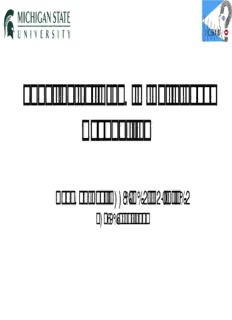
Debayan Deb, Neeta Nain, Anil K. Jain PDF
Preview Debayan Deb, Neeta Nain, Anil K. Jain
Longitudinal Study of Child Face Recognition Debayan Deb, Neeta Nain, Anil K. Jain February 22, 2018 Trace Missing Children Trace Missing Children Trace Missing Children Child Trafficking Victims1 25% 2009 201 2 1 – 18 years 1. http://www.unodc.org/documents/data-and-analysis/glotip/ Trafficking_in_Persons_2012_web.pdf 2. UNICEF Child Trafficking Victims1 Girl Boy 67% 33% 1. http://www.unodc.org/documents/data-and-analysis/glotip/ Trafficking_in_Persons_2012_web.pdf 2. UNICEF Child Prostitution2 2 million children < 20 years old 1. http://www.unodc.org/documents/data-and-analysis/glotip/ Trafficking_in_Persons_2012_web.pdf 2. UNICEF Child Face Recognition Primary Biometric Modality Yesong Wang: missing 14 year old child traced by Microsoft’s Face Recognition system [1] 1. https://news.microsoft.com/features/lost-boy-fathers-search- microsoft-technology-helped-solve-four-year-mystery/ Longitudinal Study of Face Recognition Facial Aging 01. Face recognition accuracy drops with an increase in time lapse between a subject’s gallery and probe image acquisitions. 02. Face recognition accuracies for older subjects are higher than younger ones. Longitudinal Study of Face Recognition Limited Prior Studies 01. Lack of publicly available longitudinal face dataset of children in the age group 2 to 18 years. 02. Low confidence in the accuracy of face recognition of children obtained by COTS face matchers (trained on adults).
Description: